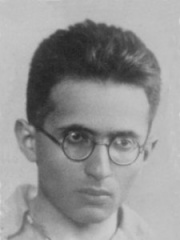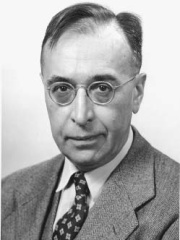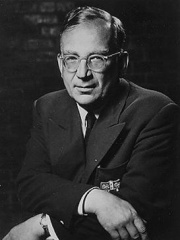
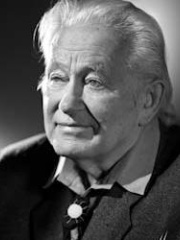
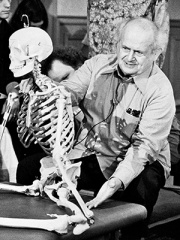
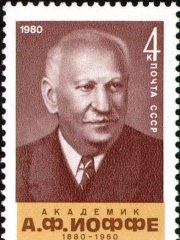

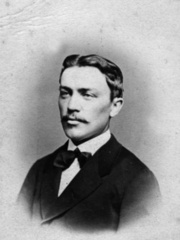
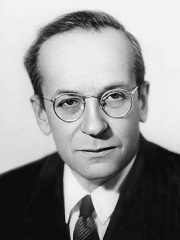
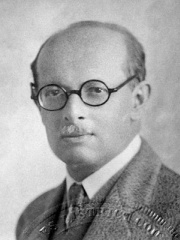
The Most Famous
PHYSICISTS from Ukraine
This page contains a list of the greatest Ukrainian Physicists. The pantheon dataset contains 851 Physicists, 15 of which were born in Ukraine. This makes Ukraine the birth place of the 14th most number of Physicists behind India, and Switzerland.
Top 10
The following people are considered by Pantheon to be the top 10 most legendary Ukrainian Physicists of all time. This list of famous Ukrainian Physicists is sorted by HPI (Historical Popularity Index), a metric that aggregates information on a biography's online popularity. Visit the rankings page to view the entire list of Ukrainian Physicists.

1. George Gamow (1904 - 1968)
With an HPI of 74.33, George Gamow is the most famous Ukrainian Physicist. His biography has been translated into 57 different languages on wikipedia.
George Gamow (sometimes Gammoff; born Georgiy Antonovich Gamov; Russian: Гео́ргий Анто́нович Га́мов; March 4 [O.S. February 20] 1904 – August 19, 1968) was a Soviet and American polymath, theoretical physicist and cosmologist. He was an early advocate and developer of Georges Lemaître's Big Bang theory. Gamow discovered a theoretical explanation of alpha decay by quantum tunneling, invented the liquid drop model (the first mathematical model of the atomic nucleus), worked on radioactive decay, star formation, stellar nucleosynthesis, Big Bang nucleosynthesis (which he collectively called nucleocosmogenesis), and predicted the existence of the cosmic microwave background radiation and molecular genetics. Gamow was a key figure in the development and understanding of quantum tunneling. In his middle and late career, Gamow directed much of his attention to teaching and wrote popular books on science, including One Two Three... Infinity and the Mr Tompkins series of books (1939–1967). Some of his books remain in print more than a half-century after their original publication. The George Gamow Memorial Lectures at the University of Colorado at Boulder are given in his honor.

2. Georges Charpak (1924 - 2010)
With an HPI of 73.25, Georges Charpak is the 2nd most famous Ukrainian Physicist. His biography has been translated into 73 different languages.
Hersz Georges Charpak (French: [ʒɔʁʒ ʃaʁpak]; 1 August 1924 – 29 September 2010) was a Polish-born French physicist who received the Nobel Prize in Physics in 1992 for his invention of the multiwire proportional chamber.

3. Moshé Feldenkrais (1904 - 1984)
With an HPI of 66.35, Moshé Feldenkrais is the 3rd most famous Ukrainian Physicist. His biography has been translated into 20 different languages.
Moshé Pinchas Feldenkrais (Hebrew: משה פנחס פלדנקרייז; May 6, 1904 – July 1, 1984) was a Ukrainian-Israeli engineer and physicist, known as the founder of the Feldenkrais Method. Feldenkrais' theory is that "thought, feeling, perception and movement are closely interrelated and influence each other."

4. Abram Ioffe (1880 - 1960)
With an HPI of 64.24, Abram Ioffe is the 4th most famous Ukrainian Physicist. His biography has been translated into 36 different languages.
Abram Fedorovich Ioffe (Russian: Абра́м Фёдорович Ио́ффе, IPA: [ɐˈbram ˈfʲɵdərəvʲɪtɕ ɪˈofɛ]; 29 October [O.S. 17 October] 1880 – 14 October 1960) was a prominent Soviet physicist. He received the Stalin Prize (1942) and the Lenin Prize (1961) (posthumously). Ioffe was an expert in various areas of solid state physics and electromagnetism. He established research laboratories for radioactivity, superconductivity, and nuclear physics, many of which became independent institutes.

5. Evgeny Lifshitz (1915 - 1985)
With an HPI of 62.26, Evgeny Lifshitz is the 5th most famous Ukrainian Physicist. His biography has been translated into 25 different languages.
Evgeny Mikhailovich Lifshitz (Russian: Евге́ний Миха́йлович Ли́фшиц; Ukrainian: Євге́н Миха́йлович Лі́фшиць; 21 February 1915 – 29 October 1985) was a leading Soviet physicist and brother of the physicist Ilya Lifshitz.

6. Dmitri Ivanenko (1904 - 1994)
With an HPI of 60.18, Dmitri Ivanenko is the 6th most famous Ukrainian Physicist. His biography has been translated into 25 different languages.
Dmitri Dmitrievich Ivanenko (Ukrainian: Дмитро́ Дми́трович Іване́нко, Russian: Дми́трий Дми́триевич Иване́нко; July 29, 1904 – December 30, 1994) was a Soviet theoretical physicist of Ukrainian origin who made great contributions to the physical science of the twentieth century, especially to nuclear physics, field theory, and gravitation theory. He worked in the Poltava Gravimetric Observatory of the Institute of Geophysics of NAS of Ukraine, was the head of the Theoretical Department Ukrainian Physico-Technical Institute in Kharkiv, Head of the Department of Theoretical Physics of the Kharkiv Institute of Mechanical Engineering. Professor of University of Kharkiv, Professor of Moscow State University (since 1943).

7. Ivan Puluj (1845 - 1918)
With an HPI of 59.80, Ivan Puluj is the 7th most famous Ukrainian Physicist. His biography has been translated into 28 different languages.
Ivan Pavlovych Puluj (Ukrainian: Іван Павлович Пулюй, pronounced [iˈwɑn pʊˈlʲuj]; German: Johann Puluj; 2 February 1845 – 31 January 1918) was a Ukrainian physicist and inventor known for his early research into X-rays. His contributions were largely neglected until the end of the 20th century.

8. Vladimir Veksler (1907 - 1966)
With an HPI of 57.60, Vladimir Veksler is the 8th most famous Ukrainian Physicist. His biography has been translated into 19 different languages.
Vladimir Iosifovich Veksler (Russian: Владимир Иосифович Векслер; Ukrainian: Володимир Йосипович Векслер; March 4, 1907 – September 22, 1966) was a Soviet experimental physicist who invented the microtron. He was head of the Nuclear Physics Department of the Academy of Sciences of the Soviet Union.

9. Julius Edgar Lilienfeld (1882 - 1963)
With an HPI of 57.41, Julius Edgar Lilienfeld is the 9th most famous Ukrainian Physicist. His biography has been translated into 18 different languages.
Julius Edgar Lilienfeld (April 18, 1882 – August 28, 1963) was an Austro-Hungarian, and later American (where he moved in 1921) electrical engineer and physicist who has been credited with the first patent on the field-effect transistor in 1925. He was never able to build a working practical semiconductor device based on his concept. Additionally, because he didn't publish articles in learned journals and since high-purity semiconductor materials were not available to him, his FET patent never achieved fame, causing confusion for later inventors.
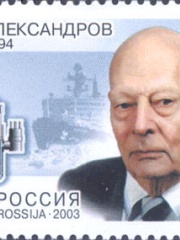
10. Anatoly Alexandrov (1903 - 1994)
With an HPI of 57.40, Anatoly Alexandrov is the 10th most famous Ukrainian Physicist. His biography has been translated into 28 different languages.
Anatoly Petrovich Alexandrov (Russian: Анато́лий Петро́вич Алекса́ндров, 13 February 1903 – 3 February 1994) was a Russian physicist who played a crucial and centralizing role in the former Soviet program of nuclear weapons. During his lifetime, Alexandrov was the recipient of many honors, civil citations, and state awards for this work and was also the director of the Kurchatov Institute and the President of the Soviet Academy of Sciences from 1975 until 1986.
People
Pantheon has 15 people classified as Ukrainian physicists born between 1845 and 1924. Of these 15, none of them are still alive today. The most famous deceased Ukrainian physicists include George Gamow, Georges Charpak, and Moshé Feldenkrais.
Deceased Ukrainian Physicists
Go to all RankingsGeorge Gamow
1904 - 1968
HPI: 74.33
Georges Charpak
1924 - 2010
HPI: 73.25
Moshé Feldenkrais
1904 - 1984
HPI: 66.35
Abram Ioffe
1880 - 1960
HPI: 64.24
Evgeny Lifshitz
1915 - 1985
HPI: 62.26
Dmitri Ivanenko
1904 - 1994
HPI: 60.18
Ivan Puluj
1845 - 1918
HPI: 59.80
Vladimir Veksler
1907 - 1966
HPI: 57.60
Julius Edgar Lilienfeld
1882 - 1963
HPI: 57.41
Anatoly Alexandrov
1903 - 1994
HPI: 57.40
Matvei Bronstein
1906 - 1938
HPI: 56.06
Gregory Breit
1899 - 1981
HPI: 55.39
Overlapping Lives
Which Physicists were alive at the same time? This visualization shows the lifespans of the 14 most globally memorable Physicists since 1700.

